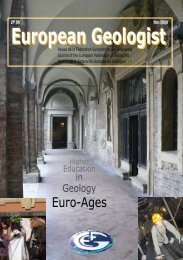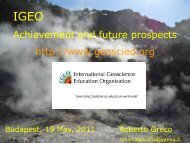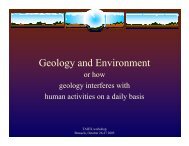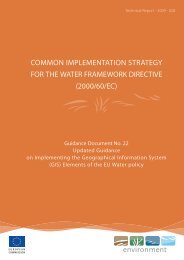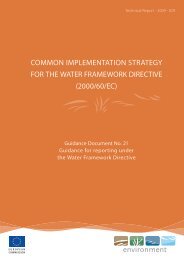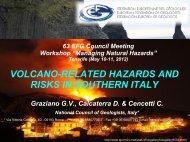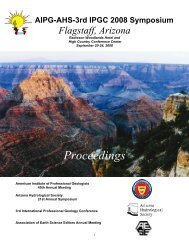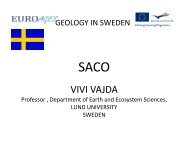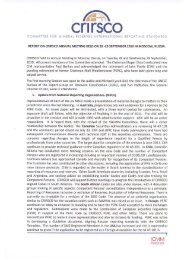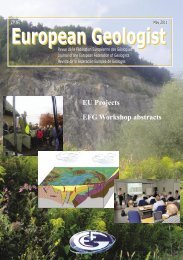European Geologist European Geologist Geoheritage - learning ...
European Geologist European Geologist Geoheritage - learning ...
European Geologist European Geologist Geoheritage - learning ...
Create successful ePaper yourself
Turn your PDF publications into a flip-book with our unique Google optimized e-Paper software.
Topical - <strong>Geoheritage</strong><br />
versity and the importance of geoconservation<br />
by systematically putting it on the<br />
agenda of decision makers or their advisory<br />
committees dealing with the organization of<br />
the territory, mitigation of natural hazards,<br />
heritage conservation (Natura2000, Commissions<br />
of Monuments and Sites, land use<br />
management plans).<br />
Think globally. Heritage conservation<br />
– of whatever type – meets a solid community<br />
support, as testified by popular events<br />
such as open monument days. A plethora<br />
of heritage organizations are active on the<br />
heritage scene thanks to subsidies. There is<br />
a large volunteer population maintaining<br />
many local initiatives, also related to geological<br />
resources such as mining museums.<br />
Our many governments spend considerable<br />
budgets on acquisition and maintenance<br />
of monuments, nature reserves or heritage<br />
sites. Why then does geoheritage remain<br />
in the background and why are so few<br />
geoscientists involved? This may be, firstly,<br />
because geoheritage has been orphaned at<br />
the institutional level. The responsibility for<br />
geoheritage has been split between nature<br />
reserves and mining heritage. Moreover,<br />
these institutions lack the structural support<br />
for assessment of geoconservation issues<br />
by a stable and influential educational/<br />
environmental/geoscientific organization.<br />
Decisions for protection are made ad-hoc<br />
but there is no ranking of sites, no thematic<br />
approach or possibility for addressing hiatuses<br />
in the geoconservation initiatives.<br />
Secondly, geoheritage initiatives are developed<br />
in near-isolation. There is no representation<br />
of Belgium or its subdivisions on<br />
the <strong>European</strong> / international scene regarding<br />
the promotion of geoheritage conservation<br />
and sustainable development, e.g. the<br />
<strong>European</strong> Association for the Conservation<br />
of the Geological Heritage, Pro-GEO, or<br />
<strong>European</strong> Geopark Network, EGN.<br />
Protecting geosites is the first step in the<br />
more holistic geopark approach, enhancing<br />
the sense of place and enlarging the<br />
leisure industry. Geoparks are a hot issue:<br />
the geopark concept was initiated in 1991<br />
with the Digne Declaration, made official in<br />
2000 with the <strong>European</strong> Geopark Network<br />
and has conquered the world in less than<br />
a decade. The Global Geopark Network is<br />
likely to become a UNESCO Programme<br />
to which our governments will have to pay<br />
equal attention as to World Heritage and<br />
Man and Biosphere programmes. Belgium<br />
has the potential to develop geoparks, both<br />
in the north and the south as well as crossboundary.<br />
The geoscientific community can<br />
make itself the messenger of new ideas concerning<br />
conservation and must be prepared<br />
to introduce the geopark concept right now.<br />
In the absence of a clear framework of<br />
geoheritage concepts in Belgium, creative<br />
use is being made of terms, such as geopark<br />
or its translations, without reference to the<br />
internationally accepted standard definition.<br />
However, the visitor management and<br />
stakeholder cooperation of the National<br />
Park Hoge Kempen is reminiscent of the<br />
<strong>European</strong> Network of Geoparks. Upgrading<br />
this and other ‘park’ areas, e.g. the Vallée<br />
du Viroin to EGN status requires making<br />
some administrative adaptations but resistance<br />
appears to be more of a psychological<br />
nature, because of fears of having to give in<br />
on biodiversity protection, or more generally<br />
because the operating mode of the<br />
network of geoparks is still unknown.<br />
Conclusions<br />
Due to its complex geological makeup<br />
and intensive use of mineral resources,<br />
Belgium has a rich geological heritage, of<br />
worldwide importance, as shown by the<br />
great concentration of chronostratigraphic<br />
stage names from such a tiny area.<br />
The knowledge society, however, is no<br />
longer connected to the geological substrate,<br />
which is intricately linked with<br />
the history of the country. The concept of<br />
heritage is a cultural construction, a value<br />
attributed to natural sites or areas and/or to<br />
their historical use. Similarly to biodiversity<br />
and cultural heritage, geoheritage must be<br />
recognizable and interesting for scientific,<br />
educational, esthetic and/or recreational<br />
purposes. No identification and assessment<br />
of the value of geoheritage is possible without<br />
geoscientists.<br />
Reference<br />
Dejonghe, L. (ed.). 2006. Chronostratigraphic units named from Belgium and<br />
adjacent areas. Geologica Belgica 9/1-2, 1-225.<br />
Dejonghe, L., Jumeau, F. 2007. Les plus beaux rochers de Wallonie. Géologie et<br />
petite histoire. Service géologique de Belgique Collection Geosciences, 358 pp.<br />
Dejonghe, L., Wuyts, K., Ketelaers, Q. 2009. Géologie & Tourisme en Belgique /<br />
Geologie & Toerisme in België. Service géologique de Belgique / Belgische Geologische<br />
Dienst, 101 pp.<br />
Goemaere, E. (ed.), 2010. Terres, pierre et feu en vallée mosane. L’exploitation des<br />
ressources naturelles minérales de la commune d’Andenne: géologie, industries,<br />
cadre historique et patrimoines culturel et biologique. Service géologique de<br />
Belgique / Belgische Geologische Dienst Collection Geosciences, 544 pp.<br />
Hatert, F., Deliens, M., Fransolet, A.M., Van Der Meersche, E. 2002. Les minéraux<br />
de Belgique. Muséum des Sciences Naturelles, Bruxelles, 304 pp.<br />
IUCN, 2008. Motion CGR4.MOT055 - IUCN on Conservation of geodiversity and<br />
geological heritage. World Conservation Congress, Barcelona, 5-14 October 2008.<br />
As a second step, no protection and conservation<br />
of geoheritage is possible without<br />
public consent and support by the authorities<br />
in charge. Not unexpectedly, geoscientists<br />
are convinced that geology is interesting,<br />
but to the general public the same<br />
geology may be inaccessible and boring.<br />
Therefore it is necessary to ‘humanize’ geology<br />
to make it understandable for ordinary<br />
people not accustomed to the geological<br />
scale of time and dimension. Besides geoscientists,<br />
who are aware of the importance<br />
of geoheritage, and science communicators<br />
who are able to take this message to the<br />
public, geosites need ‘community champions’,<br />
proud of their geoheritage, and who<br />
can promote the assets of their locality or<br />
region. Sustainable conservation of geoheritage<br />
can only succeed when this cooperation<br />
is functional and the barriers between<br />
the different forms of heritage are overcome.<br />
Van Der Meersche, E., De Paepe, P., Stoops, G. 2010. Minerals with Belgian Roots<br />
from hopeite (1824) to tazieffite (2009). Academia press, Gent, 231 pp.<br />
<strong>European</strong> <strong>Geologist</strong> 34 | November 2012<br />
11



